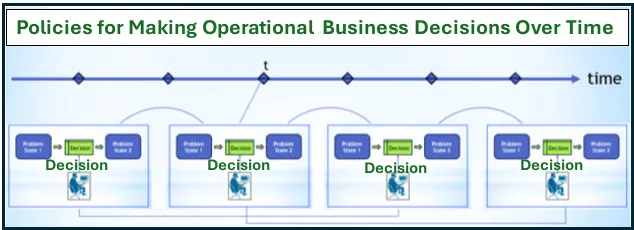Decisions vs Policies
Blog: For Practitioners by Practitioners!
The latest post by Adam DeJans Jr. is so important that we decided to reproduce it here. He questions whether we always need a model to make a decision and describes the essential difference between decisions and policies. “A decision is an action you take given what you know now. A policy is a rule for deciding over time. Decisions are moments. Policies are patterns.” Link
What is a decision? What is a Policy?
Years ago, I was in a meeting where someone said: “We just need the model to make the decision.”
Everyone nodded. It sounded visionary.
But over time, I realized that sentence hides one of the deepest misunderstandings in analytics.
Because making a decision and having a policy are not the same thing. And knowing the difference changes how you build every system that’s supposed to “decide.”
A decision is an action you take given what you know now. A policy is a rule for deciding over time.
Decisions are moments. Policies are patterns.
We make decisions every day: assign a truck, build 200 Camrys, reorder parts.
But the moment you take one, the world moves. New information appears, uncertainty unfolds, and yesterday’s “optimal” might become tomorrow’s mistake.
That’s why Warren Powell’s framing of sequential decisions changed how I think.
It showed that a decision without context is just an impulse. A policy is a strategy.
Policies answer the question:
“Given what I know right now, what should I do every time this situation arises?”
It’s what humans already do instinctively:
– If it’s raining, bring an umbrella.
– If the data is noisy, use a robust method.
– If the customer hesitates, ask about their pain point.
In math, we write it as taking action when in state. Simple notation, deep meaning.
It captures judgment and not just reaction.
As Joannes Vermorel often points out, organizations love “decisions” and “data,” but rarely define what good even means or how it changes when reality shifts.
They chase one-off models and dashboards, like tourists taking pictures instead of learning the landscape.
Optimization forces harder questions:
– What’s my decision space?
– What state am I really in?
– What happens next if I act this way?
We need to stop chasing outcomes and start designing systems that decide well repeatedly.
Building one decision is easy. Building a policy that works over time is hard.
You must balance:
– Information vs. action
– Now vs. later
– Local vs. global
– Certainty vs. uncertainty
That’s why frameworks like Sequential Decision Analytics matter; they give language and structure to the dynamics of real problems.
On one of my early optimization projects, I used to obsess over whether the model made the right call that day.
Then a supply disruption hit and everything failed. Because we’d built a decision, not a policy.
Since then, I ask three questions in every project:
1. What’s the policy behind this model?
2. How does it adapt when the world changes?
3. Can it be expressed, audited, and improved?
That mindset shift, from decision to policy, changed my career.
Leadership itself is a policy problem. A great leader doesn’t make one good decision. They build systems that keep producing good decisions long after they’re gone.
That’s the true promise of optimization:
Not to make faster decisions, but to design repeatable decision quality.
